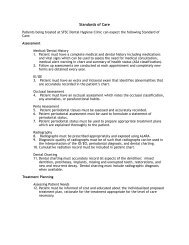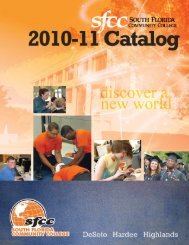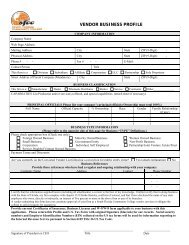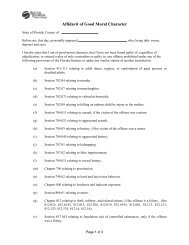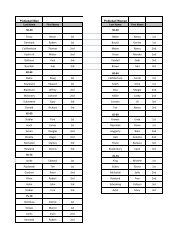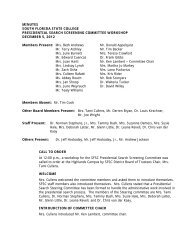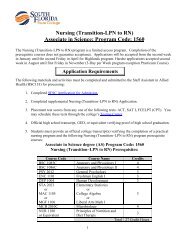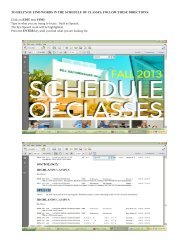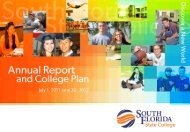Plan (UAP) and/or budget requests for the upcoming fiscal year.3.3.1.1 Educational ProgramsSFCC provides a comprehensive range of educational programs compatible with the mission and purposeof the institution. This narrative further identifies expected outcomes in educational programs, includingstudent learning outcomes, as part of an ongoing institutional effectiveness process described in CoreRequirement 2.5.In 2007, the Institutional Effectiveness Department and Academic Quality Committee formalized a newframework for assessing educational programs. The new process created an electronic educationalprogram assessment format using the college intranet to report consistently and document efforts toachieve program missions, student learning outcomes, performance measures, performance standards,data collection methods, analysis of findings, and improvement efforts. The initiation of the learningoutcomes focus began with an assessment workshop presented by Dr. Peggy Maki that introduced thenew outcomes measurement process.Student learning outcomes are identified at the institutional, program, and course level. Institutionally,there are courses that introduce or reinforce college-wide general education outcomes. For morediscussion on general education student learning outcomes see CR 2.7.3. Additionally, each educationalprogram has designated program mission, program outcomes, performance measures, and programprofile data used for assessment purposes. At the course level, student learning outcomes or objectivesand competencies are identified in each course syllabus.Assessment of Student Learning OutcomesThe measurement of student learning achievement occurs at the three distinct levels previouslymentioned. At the institutional level, measures such as the Community College Student Survey ofEngagement (CCSSE), Student Opinion Survey (SOS), Core Indicators of Effectiveness,Integrated Postsecondary Education Data System (IPEDS), and graduate surveys providevaluable benchmarking and information regarding the overall effectiveness of the college in meeting itsmission of providing student learning.At the programmatic level, the primary instrument for documenting student accomplishment of learningis the Educational Program Assessment (EPA). The EPA is developed, monitored, and assessed bydiscipline faculty. Outcome performance measurements found in the EPA may include accreditationfindings, licensure or certification pass rates, retention, graduation rates, employer satisfaction surveys,student satisfaction surveys, job placement rates, and outcomes specific to exit knowledge, skills andcompetencies. The educational program is assessed and documented annually; activities forimprovement in program performance and student learning are identified during the annual assessment.Additional mechanisms used to assess and improve program performance and student learning at theprogram level include input from advisory committees and information gathered during the accreditationof selected technical programs. All technical programs have active advisory committees who providequalitative summaries regarding currency of curriculum, performance of graduates once employed, andguidance to program faculty regarding emerging trends and issues. Accreditation teams also provide indepthassessment and recommendations for improvement to the Dental Hygiene, Dental Assisting,Automotive Service Technology, and Radiology programs.The course-level assessment of student learning is determined by faculty and discipline or departmentcriteria established in the course syllabi. Data sources used to assess student learning may includeresults from embedded assessments, projects, rubrics, course projects, exit exam pass rates, retentionrates, productive grade rates, success in subsequent courses (developmental courses), focus groups, and<strong>South</strong> <strong>Florida</strong> Community College Page 79 / 202student evaluation of instruction. For those courses offered via distance learning there will also be anadditional course-level comparison with student performance in the same subject, but a traditionalclassroom setting. Dual-enrolled courses receive a yearly analysis to assure the quality of educational
The course-level assessment of student learning is determined by faculty and discipline or departmentcriteria established in the course syllabi. Data sources used to assess student learning may includeresults from embedded assessments, projects, rubrics, course projects, exit exam pass rates, retentionrates, productive grade rates, success in subsequent courses (developmental courses), focus groups, andstudent evaluation of instruction. For those courses offered via distance learning there will also be anadditional course-level comparison with student performance in the same subject, but a traditionalclassroom setting. Dual-enrolled courses receive a yearly analysis to assure the quality of educationaldelivery.Educational Program Outcome AchievementThe EPA Handbook provides direction for each component of the EPA assessment. Educational programsannually report their outcomes achievement using the EPA electronic documentation format. Facultymembers review program outcomes using established performance standards to compare with collecteddata results, analyze the findings, and then identify improvement activities. Improvement activities maybe minor and readily carried out, or may be more complex requiring new funding or sustainedimplementation efforts. These initiatives may result in modification to the annual Unit Action Plan (UAP)and/or budget or capital outlay requests. In all cases, assessment results are used to improve theeducational program and enhance student learning.The Academic Quality Committee (AQC) annually audits all EPAs for completion and constructivecritique. Members of the AQC subcommittee have been instrumental in the writing and assessment ofprogram outcomes. The subcommittee uses an audit tracking sheet to document successfulcompletion of the EPA and makes recommendations to the AQC for overall improvements to the existingEPA process.Program Review of educational programs occurs regularly according to procedure. SFCC reviewseducational programs every three years and provides requested accountability data to the state.Beginning in 2010, the college provided additional program information to each department in the formof a program profile. The program profile provides information about program viability and qualityindicators that may or may not be included in the EPA but will assist administration and program facultyto monitor program performance against set standards. Quality indicators, such as full-time to part-timefaculty ratios, course retention rates, and graduate/employer satisfaction data, are measures of aprogram that can be influenced by the academic department and college. Viability indicators suchas persistence/retention data, enrollment trends, or future employment projections are in large measureout of the control of the college and department.Evidence of ImprovementIn review of the 2007-2008 and 2008-2009 EPA assessments, the AQC EPA Review Subcommitteeidentified extensive redundancy in technical program assessment, which was repetitive and difficult tomanage. The EPA Review Subcommittee recommended to AQC that technical programs beconsolidated under larger program classifications, yielding 22 technical program EPAs rather than 64.Since many certificate programs are a part of the Associate in Applied Sciences degree in the same fieldand the course work required in many certificates are also in the Associate in Applied Science degree,the change in the EPA process was felt to be justified; the change became effective for the 2009-2010reporting cycle.A sample set of EPAs for the past three years are in the table below to demonstrate evidence of theassessment cycle resulting in improvement efforts of educational programs.Arts and Sciences:<strong>South</strong> <strong>Florida</strong> Community College Page 80 / 202EducationalProgramEPA 2007-08 EPA 2008-09 EPA 2009-10
- Page 2 and 3:
Compliance Report - South Florida C
- Page 4 and 5:
2.1Degree-granting AuthorityThe ins
- Page 6 and 7:
County. He is a chiropractic physic
- Page 8 and 9:
Monthly Financial Report for June 2
- Page 10 and 11:
(DBOT) Policy 1.02.The college miss
- Page 12 and 13:
Institutional effectiveness is eval
- Page 14 and 15:
and determined to use the Integrate
- Page 16 and 17:
A number of planning processes take
- Page 18 and 19:
Trustees | Budget Workshop 2010-201
- Page 20 and 21:
SFCC Quick Facts, Web SiteStudent S
- Page 22 and 23:
SFCC College Catalog 2010-2011 (A.A
- Page 24 and 25:
Statewide Course Numbering SystemSt
- Page 26 and 27:
technology; understand that accurat
- Page 28 and 29:
SFCC College Catalog 2010-2011, pp.
- Page 30 and 31:
Faculty Roster Form2.8FacultyThe nu
- Page 32 and 33: SFCC Administrative Procedure 5226
- Page 34 and 35: faculty roster offered in support o
- Page 36 and 37: Library Owned Collections and Resou
- Page 38 and 39: Florida College System through a st
- Page 40 and 41: Student Opinion Survey, p. 6Weeding
- Page 42 and 43: eceive assistance in goal setting a
- Page 44 and 45: Testing CenterTesting Report 2009-2
- Page 46 and 47: independent auditors found that fin
- Page 48 and 49: 2.11.2Annual Financial Report FYE 2
- Page 50 and 51: Trustees | Budget Workshop 2009-201
- Page 52 and 53: Space Inventory August 2010Technolo
- Page 54 and 55: Proposed 2009 Changes to Mission, V
- Page 56 and 57: Presidential Search PamphletSBE Rul
- Page 58 and 59: SBE RuleSBE Rule 6A-14.0261, Genera
- Page 60 and 61: to the Vice President for Administr
- Page 62 and 63: Delegation of Operational ControlWi
- Page 64 and 65: SFCC Foundation Bylaws, PurposeSFCC
- Page 66 and 67: policies ensure that equal opportun
- Page 68 and 69: FS 112.313, Standards of Conduct fo
- Page 70 and 71: Administrative | Administrative Pro
- Page 72 and 73: Academic and Administrative Officer
- Page 74 and 75: Administrative | Employee HandbookA
- Page 76 and 77: FS 1012.86, Community College Emplo
- Page 78 and 79: DBOT Policy 2.06, General Powers, D
- Page 80 and 81: DBOT Policy 1.14 mandates that all
- Page 84 and 85: Arts and Sciences:EducationalProgra
- Page 86 and 87: Community/Public APA 2008-09 APA 20
- Page 88 and 89: 2008-09 APA Financial Aid2008-09 AP
- Page 90 and 91: Program ProfileSFCC Administrative
- Page 92 and 93: Phlebotomy ProgramPresident's Counc
- Page 94 and 95: Hardee County Economic Development
- Page 96 and 97: SFCC College Catalog 2010-2011, pp.
- Page 98 and 99: SFCC Administrative Procedure 3113,
- Page 100 and 101: Credit is also awarded through Coop
- Page 102 and 103: compliance with comprehensive requi
- Page 104 and 105: through testing services to assure
- Page 106 and 107: • Analyzes data within department
- Page 108 and 109: SEI Survey Form w-LabSyllabus Templ
- Page 110 and 111: SFCC College Catalog 2010-2011, pp.
- Page 112 and 113: issues brought before the committee
- Page 114 and 115: that can be used as portables in va
- Page 116 and 117: with a rich and flexible set of cou
- Page 118 and 119: Our college liaison for special nee
- Page 120 and 121: SourcesCommittee Handbook 2010-2011
- Page 122 and 123: Technology Usage GuideUser Profile
- Page 124 and 125: General Education Outcome #3: Stude
- Page 126 and 127: the role that general education pla
- Page 128 and 129: SFCC College Catalog 2010-2011, p.
- Page 130 and 131: All courses taught at SFCC are part
- Page 132 and 133:
Syllabus: PhlebotomyA.A.S. Degree P
- Page 134 and 135:
Department staff engage with the ne
- Page 136 and 137:
conference. Completed evaluation in
- Page 138 and 139:
SFCC Administrative Procedure 5011
- Page 140 and 141:
Strategic Plan 2009-2014, p. 13Welc
- Page 142 and 143:
Faculty Handbook, p. 51SFCC Adminis
- Page 144 and 145:
Faculty Handbook, pp. 42-49Faculty
- Page 146 and 147:
Table 3.8.1-2: Student Opinion Surv
- Page 148 and 149:
Student Opinion Survey 2007-08Stude
- Page 150 and 151:
My overall impression of thissessio
- Page 152 and 153:
Library Information Network and Coo
- Page 154 and 155:
South Florida Community College (SF
- Page 156 and 157:
Student Services | SFCC College Cat
- Page 158 and 159:
catastrophic failure or becomes irr
- Page 160 and 161:
Technology Support ManualTechnology
- Page 162 and 163:
A generally recognized indicator of
- Page 164 and 165:
FS 1011.84, Procedure for Determini
- Page 166 and 167:
Financial Audit FYE 2008Financial A
- Page 168 and 169:
FS 11.45, Definition; Duties; Autho
- Page 170 and 171:
Surplus or excess daily funds earn
- Page 172 and 173:
• requesting or coordinating the
- Page 174 and 175:
Finance | State of Florida Accounti
- Page 176 and 177:
2009-2010 FCSRMC Primary CoverageCo
- Page 178 and 179:
Training programs are required of s
- Page 180 and 181:
esponsibility for occupational safe
- Page 182 and 183:
Training Records, BiomedicalWaste M
- Page 184 and 185:
The August 2010 Employee Satisfacti
- Page 186 and 187:
Agri-business Specialization (A.A.S
- Page 188 and 189:
SACS Approval for Distance Learning
- Page 190 and 191:
Classroom Complex (Building B). Inc
- Page 192 and 193:
Spring 2010 N 3651 2445 1285 465 87
- Page 194 and 195:
Three Year Course Review for Applie
- Page 196 and 197:
SFCC College Catalog 2010-2011, pp.
- Page 198 and 199:
Student Services | Schedule of Clas
- Page 200 and 201:
SFCC College Catalog 2010-2011, pp.
- Page 202 and 203:
Student Services | SFCC College Cat
- Page 204 and 205:
Student Services | Student Handbook



